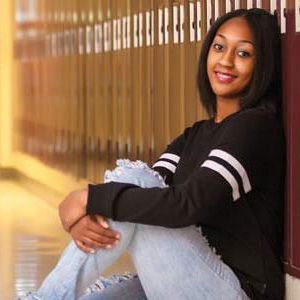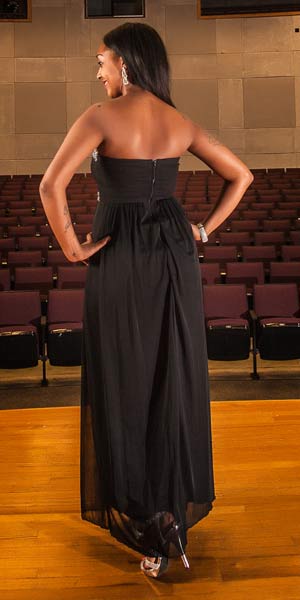 Seventeen-year-old Keeshara Theus had a ritual after every basketball game: ice and massage her painful, aching back.
Seventeen-year-old Keeshara Theus had a ritual after every basketball game: ice and massage her painful, aching back.
Keeshara had lived with the discomfort for years. During a routine physical required to play sports when she was 13, Keeshara learned she had mild scoliosis. Three years of physical therapy did nothing to slow the progression of the curve in her spine, and her condition began to affect her participation in the sport she loves.
“I started on the varsity team at Norcom High School as a sophomore, but by my junior year, the trainer was telling coach that I could only play two minutes each quarter,” Keeshara says. “I couldn’t do much more than that. I was in so much pain during one game, I couldn’t play at all.”
By then Keeshara’s pediatrician had referred the family to Dr. Sheldon St. Clair, a pediatric orthopedic and sports medicine surgeon at CHKD who has worked with scoliosis patients since CHKD opened its surgical suite in 1985.
Adolescent onset of scoliosis such as Keeshara’s affects girls 10 times more often than boys. About three percent of the general population has a curvature in their spine greater than 10 degrees. But Keeshara’s curvatures were much greater – X-rays showed a significant curve near her chest which bent 52 degrees and another above her pelvis twisting 40 degrees in the opposite direction.
Dr. St. Clair prescribed physical therapy as a first line of treatment, and Keeshara diligently attended the sessions at the CHKD Health Center at Kempsville. But the curvatures and pain continued to worsen. When a new set of X-rays revealed an increase in the curvature of her upper spine to 58 degrees, Dr. St. Clair recommended surgery.
“I had three ribs poking out on my back,” Keeshara says. Rib humps like hers are common indicators of scoliosis. “I didn’t want surgery, but I wanted to play basketball.”
 “I wanted my daughter to be pain-free,” Ann Theus says. “And Keeshara’s lump in her back was so bad you could see it through her shirt.”
“I wanted my daughter to be pain-free,” Ann Theus says. “And Keeshara’s lump in her back was so bad you could see it through her shirt.”
CHKD’s scoliosis program includes a unique collaboration of seven pediatric neurosurgeons and orthopedic surgeons as well as a team of pediatric anesthesiologists, a dedicated operating room staff for scoliosis patients, pediatric intensive care specialists, nurses who are trained in scoliosis treatment, and pediatric physical therapists. This multidisciplinary surgical approach to scoliosis allows surgeons who understand the interdependency between the bones and nerves of the spine to collaborate and achieve the best possible outcome for the patient. Keeshara’s procedure would be performed jointly by Dr. St. Clair and Dr. John Birknes, a pediatric neurosurgeon at CHKD.
Surgery was scheduled for the week following Keeshara’s junior basketball season. The goal was to straighten Keeshara’s spine, relieve her pain and get her back on the court in time to play during her senior season.
“The challenges in this case were the pre-operative planning and surgical technique we would use to correct her scoliosis,” Dr. St. Clair says. “We used a relatively new procedure called a Ponte osteotomy, which would give Keeshara more flexibility in her back.”
During Keeshara’s seven-hour procedure, the surgeons used two cobalt-alloy rods and 18 screws to straighten the upper section of her spine. With the upper spine straight, the lower section of her spine will correct itself over time.
 The post-surgical results were almost immediate. “When I started walking around after surgery, there was no pain,” Keeshara says. “I knew it was a success.”
The post-surgical results were almost immediate. “When I started walking around after surgery, there was no pain,” Keeshara says. “I knew it was a success.”
Keeshara spent several days in the hospital before continuing her recovery at home. She immediately began physical therapy to strengthen her back, working with the sports physical therapists in CHKD’s sports medicine program.
This fall, almost fully healed, Keeshara began her senior year pain-free and hopeful for a great senior season. She keeps an X-ray photo of her spine on her mobile phone as a lasting reminder of how far she’s come.
“Almost all patients like Keeshara come back six to 12 months after surgery extremely happy about their ‘new spine’ and are so pleased that they had surgery,” says Dr. Birknes. “Most patients are excited about how active they can be after their correction.”
Keeshara is one of those satisfied patients. In addition to fully enjoying her senior year on the basketball court, she found herself on another court last fall – Norcom’s homecoming court – where she represented her class as Miss Senior.
“I even wore a backless gown to homecoming this year,” says Keeshara, adding that she had her hair pulled to the side to show off her newly straightened spine.